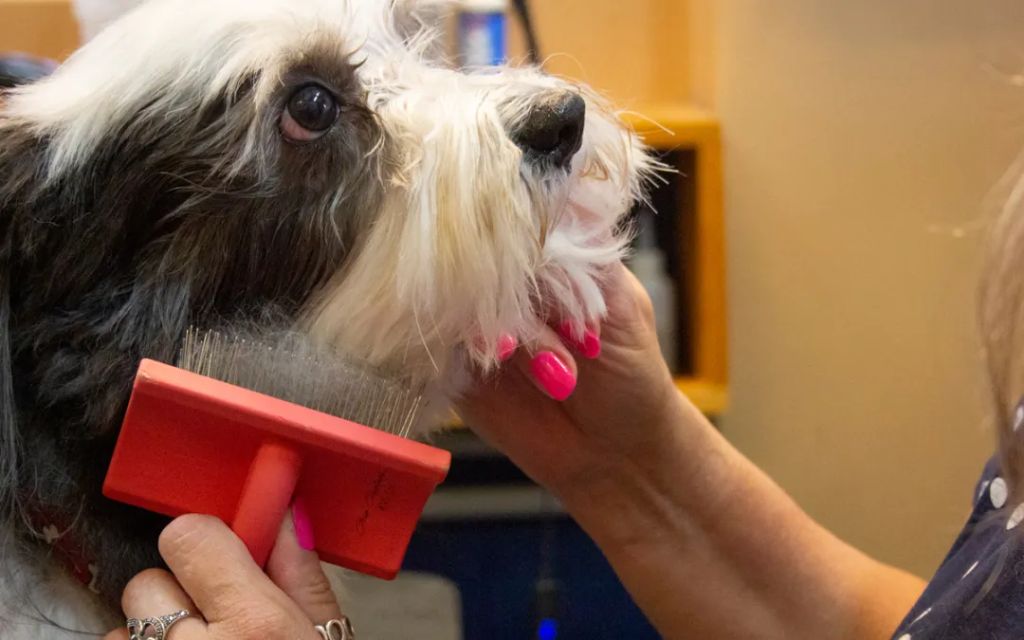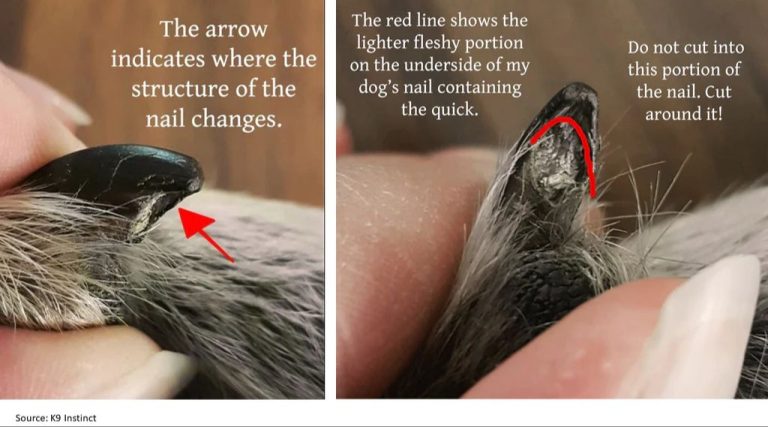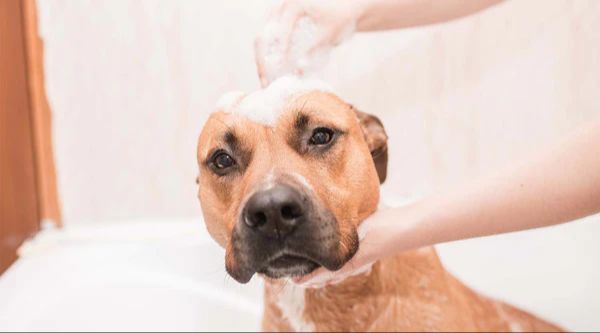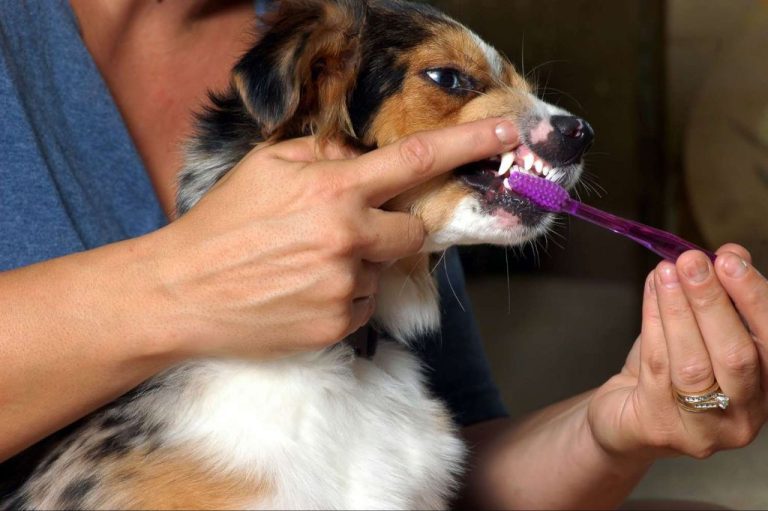Grooming Your Dog’S Face: Tips For Keeping It Clean And Tidy
Grooming a dog’s face is an essential part of their routine care and maintenance. Keeping a dog’s face clean and tidy provides health benefits, improves their appearance, and strengthens the human-animal bond.
A well-groomed dog face has no dirt, eye discharge, tear stains, food debris, or excessive hair that can irritate their eyes or nose. Regular face grooming prevents skin infections, allergies, and other issues that can occur if dirt, bacteria, or irritants build up on the skin (Source). It also allows you to carefully inspect their face for any cuts, parasites, or signs of problems that require veterinary attention.
Additionally, trimming the hair on a dog’s face helps keep their eyes, nose, and mouth clear for eating and breathing. Neatly trimmed facial fur gives dogs a tidy, attractive look. The grooming process promotes bonding and trust between owner and pet.
With some basic tools and techniques, dog owners can keep their pet’s face clean on their own as part of a regular routine. This provides an opportunity to care for the dog’s health and appearance between professional grooming appointments.
Brushing
Regular brushing provides many benefits for your dog’s health and hygiene. Brushing helps distribute the natural oils in your dog’s coat, removing dirt and debris while making the coat shiny and healthy (CBS News, 2011). It also stimulates blood circulation, keeping the skin nourished. The brushing motion helps loosen and remove dead hair, preventing excessive shedding around your home.
Brushing is a great way to bond with your dog and provides a calming, relaxing experience for them. The repetitive motions release feel-good hormones in dogs similar to when they are petted. Set aside 10-15 minutes 1-2 times per week for a brushing session. Your dog will look forward to this special pampering time.
Use a high-quality bristle brush suited for your dog’s coat type. Brush in the direction of hair growth using gentle but firm strokes. Pay extra attention to body areas more prone to tangles, like behind the ears, under the arms, and the hind legs. Regular brushing keeps your dog’s coat tidy and is an essential part of their grooming routine (iHeartDogs, 2023).
Trimming
Trimming the hair around your dog’s eyes, lips, and ears periodically can help keep their face looking tidy and prevent issues. Excess fur around the eyes can irritate them and obstruct your dog’s vision. Trimming around the lips allows your dog to eat and drink easily without getting food or water stuck in long hairs. Keeping the fur around the ears trimmed helps improve airflow and reduce moisture buildup that can lead to infections.
You’ll want to trim the hair around the eyes often, as close as every couple weeks for fast growing hair. Use rounded tip scissors and carefully trim the hair around the eyes in the direction it grows. Be very gentle and careful not to trim the whiskers. For the lips and ears, monthly trimming is usually sufficient. Carefully use straight scissors to trim the fur around the lips and outer ear flap in the direction it grows. Always give treats and praise to keep your dog comfortable during trimming.

If your dog won’t hold still for trimming, enlist a helper to keep them calm or visit a professional groomer. With patience and positive reinforcement, you can help your dog get used to facial trims.
Cleaning Eyes
Keeping your dog’s eyes clean is an important part of facial grooming. Eye discharge, tear stains, and crusty buildup can irritate your dog’s eyes and lead to infections.
Use a soft, warm, damp cloth or an eye wipe specially formulated for dogs to gently wipe away any crust or discharge from the eyes. Be very gentle and don’t scrub. You can also use sterile saline eye wash or an eye wash made for dogs, such as Vetericyn Eye Wash.1 Gently wipe from the inner corner of the eye outwards. Use a separate part of the cloth for each eye to avoid spreading any irritants or bacteria.
For tear stains, daily eye cleaning can help remove reddish-brown stains. There are also products formulated to reduce tear staining that can be applied daily. Using filtered or distilled water instead of tap water when cleaning the eyes may help reduce stains over time.
If discharge, tearing, or stains persist even after regular cleaning, see your veterinarian, as it could signal an underlying eye condition.
Cleaning Ears
Keeping your dog’s ears clean is an important part of facial grooming. Ear wax and debris can accumulate quickly, leading to irritation and infection. To keep your dog’s ears tidy:
Wipe the outer ears every 1-2 weeks with a cotton ball or gauze soaked in a veterinarian-approved ear cleaning solution. Gently wipe any dirt or wax you see from the outer ear flap and canal entrance, taking care not to push debris further into the ear canal. Massage the ear base to help loosen wax. After cleaning, dry thoroughly with a clean towel.[1][2]
Check with your veterinarian before using any cleaning products, especially if your dog has an ear infection. Never use cotton swabs or insert objects into the ear canal, as this can damage the eardrum.
Brushing Teeth
Brushing your dog’s teeth daily is one of the most important parts of facial grooming. Daily brushing helps prevent plaque and tartar buildup, which can lead to periodontal disease if left untreated. According to the VCA, periodontal disease affects over 80% of dogs by age 3 (source).
To properly brush your dog’s teeth:
- Use a soft-bristled toothbrush designed for dogs.
- Apply a pea-sized amount of veterinary-approved dog toothpaste.
- Gently brush in circular motions along the outer surfaces of the teeth and gums.
- Gradually work up to brushing the inner surfaces as your dog gets accustomed to the process.
- Aim to brush for 2 minutes total each day, doing a few teeth at a time if needed.
Daily brushing removes plaque before it hardens into tartar. Tartar above the gumline not only looks unsightly, but it can also lead to gum infection and tooth loss if not properly managed. By brushing your dog’s teeth daily, you can help prevent these issues and promote good oral health.
Bathing Face
When bathing your dog’s face, it’s important to use dog shampoo sparingly and avoid getting soap in your dog’s eyes. According to Wag Walking, you should wet a washcloth with warm, soapy water and gently wipe your dog’s face. Be very careful around the eyes and limit soap usage to prevent irritation.
Pedigree advises bathing your dog’s face at the same time as their full-body bath. Use a fresh damp washcloth to wipe your dog’s face clean of shampoo residue. You can also use a moist cotton ball to gently clean around the eyes. Limiting soap and thoroughly rinsing will help prevent dryness or irritation.
Grooming Tools
Having the proper tools is essential for grooming your dog’s face effectively and safely. Some key tools to have include:
A soft-bristled brush is great for gently brushing your dog’s face and removing loose hair and debris (1). Opt for a brush with soft, natural bristles. Avoid wire brushes or anything too stiff, as this can irritate your dog’s sensitive facial skin.
Trimmers allow you to neatly trim the hair around your dog’s eyes, muzzle, and beard (2). Look for trimmers designed specifically for pets, with rounded tips for safety. Always be very careful when using trimmers near your dog’s eyes and face.
Grooming wipes come pre-moistened with cleaning solutions that are gentle for regular use on your dog’s face (3). They help remove tear stains, dirt, slobber, and allergens. Choose wipes specifically formulated for dog skin and coat types.
Having high-quality tools designed for dog grooming makes the process much easier and helps keep your dog’s face clean, tidy, and comfortable.
(1) https://www.gingrapp.com/blog/9-top-pet-grooming-tools-recommended-by-professionals
(2) https://www.chewy.com/b/grooming-tools-359
(3) https://www.petedge.com/dog-grooming/grooming-tools
Signs of Problems
Some common signs of skin problems on a dog’s face include redness, swelling, and scratching. According to WebMD, redness and inflammation can indicate conditions like allergic dermatitis, bacterial infections, or yeast infections. Redness may appear as blotchy patches or small bumps. Swelling could develop from insect bites, abscesses, or allergic reactions. Persistent scratching and irritation is often the first noticeable symptom of issues like mange, ringworm, or seborrhea.
If you notice any unusual redness, swelling, or scratching on your dog’s face, take a closer look to identify potential causes. Look for small bumps, flaky skin, hair loss, lesions, or other abnormalities. Contact your veterinarian promptly if you suspect a skin issue, as timely treatment can help prevent complications. With prompt care, most skin problems can be managed. But leaving them unchecked allows conditions to worsen.
Professional Help
Sometimes grooming at home is not enough, and you may need to seek professional help from a groomer or vet. According to the Twin Peaks Veterinary Hospital, dogs with thick undercoats will need professional grooming every 8 weeks for thorough undercoat removal to help your dog’s skin breathe properly.
Signs that your dog may need to see a professional groomer include mats and tangles in their fur, overgrown nails, excess hair growth, and skin irritation or odor. Bring puppies in for their first grooming between 12-16 weeks old once they have received their vaccinations, according to Fancy Pants Pet Salon.
See a vet right away if you notice any signs of problems like red, irritated skin, open sores, or abnormal growths. Your vet can check for skin issues and parasites and provide any necessary treatment. According to Madison Animal Care, regular professional grooming every 4-8 weeks can help prevent many skin and coat problems before they start.





